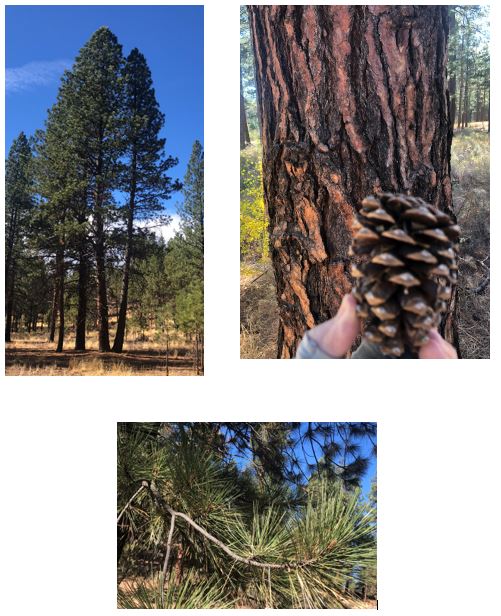Description:
Ponderosa pine is one of the most widespread conifers in North America – extending from Canada to Mexico, and from within a few miles of the west coast to the plains of Nebraska. It grows in well-watered areas of the Sierra, to the fringes of the High Desert in Oregon and some mountain ranges in the Great Basin. Excluding some of the fringe areas, a common associate is the Douglas-fir. In the High Desert near where I live, it grows with the western juniper in the Cascade/High Desert transition zone. My opinion is that if any one tree characterizes the American West it is the ponderosa pine.
This pine has a wide crown with branches well separated. Their needles, typically in groups of three, except for some areas in the Rockies where they have two, are among the longest of the conifers. The three to five inch cones have points at the end of the scales, which helps distinguish them from the Jefferey pine that have similar, slightly larger cones, but don’t have the prickly scales. Although, in my home town of Bend, Oregon, many of the cones don’t have prickly scales, but because there are no Jefferey pine in the area, that distinction isn’t necessary to tell the two species apart. The bark has a vanilla smell, especially when the sun warms the tree up. I love that smell.
There are five sub-species of this tree, three of which occur in the region. The variety benthamiana dwells in California and the western part of Oregon. Ponderosa occurs around Lake Tahoe and in the interior of Washington, Oregon, and Idaho. Scopulorum resides in eastern Nevada, Utah, and the Rockies. There is also another possible variety called washoensis or the Washoe pine. There doesn’t appear to be any consensus on its status. Regardless of the debate it occurs around the east side of Lake Tahoe, and in the northeast corner of Nevada and possible other nearby places in Oregon and California. This tree usually grows a little lower in elevation than the ponderosa, and prefer drier sties.
Personal Observations:
I have recorded this tree in almost every mountainous area of the west. I have also spotted them while driving up Interstate 5 through the Willamette Valley in Oregon. Valley locations are a little unusual for this tree. Some consider those located there to be a separate variety, but there is not wide consensus on that issue.
They grace my neighborhood in the western part of Bend, Oregon, yet fizzle out as you get to the eastern part of my town, to be replaced by western juniper. A little west of my neighborhood, in Shevlin Park, they also are part of a continuum of conifers that start with wester juniper, then advances to ponderosa, then lodgepole pine, western larch, Douglas-fir, grand fir, and finally Engelmann spruce as you go up in elevation.
While visiting eastern Nevada I logged them in the lower elevations of both Moriah Wilderness Area and the Great Basin National Park.
In rambling through both the Strawberry and Mill Creek Wilderness Areas of eastern Oregon, I found them in the middle elevations, often associated with western juniper at their lower elevation range, and Douglas-fir or grand fir higher up. Before visiting Horse Ridge Natural Area east of Bend, Oregon, I asked if there was a chance of other conifers being there, besides the common western juniper, and was told “no you’ll only find juniper here, try Pine mountain”, which I’d already visited. But, by gosh I found a lone ponderosa there. I searched all around trying to find more, but my old legs said it was time to head down the steep mountain. It’s likely that there are more, and perhaps someday I will find them.
More recently I searched for them in three places in eastern Oregon where they were not recorded and was lucky enough to find them. I found them on Grizzly peak northeast of Redmond, as well as just a few on Gray Butte, which is a little closer to Redmond. There is also a small population on the top of Powell Butte, also near Redmond.


